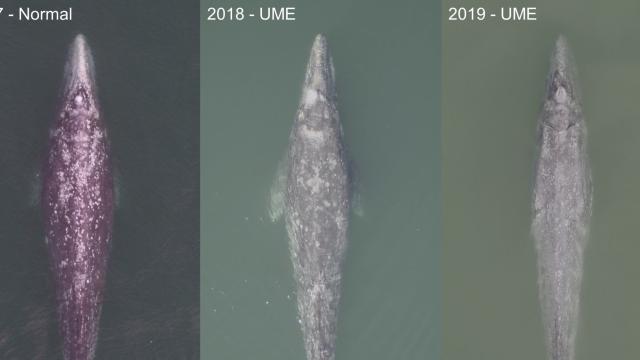An unusual mortality event of grey whales off the coast of Mexico is disturbingly persistent, according to a study published this week in the Marine Ecology Progress Series. The die-off began in 2019, and the grey whale death count is currently at 384, though the actual number may be higher.
Unusual mortality events describe the sudden die-offs of marine mammals; they happen too often for comfort, and are often linked with human causes, from discarded fishing lines to oil spills. The last grey whale mortality event occurred at the turn of the millennium, when more than 600 deaths were chronicled along the U.S. Pacific coast. The recent event’s cause is unknown, though the paper suggests that food scarcity in the Barents Sea, where the whales seasonally feed, may be responsible.
Back in 2017, the research team set out to look at how much energy lactating female whales transferred to their calves. Over the next three years of observations, which used drones to measure the size of the whales, the team found their study subjects getting slimmer and slimmer. As far as whales go, that means that their energy reserves — mostly stored in their lightweight blubber — were becoming skimpier with each migration.
“What stood out in this case was that we had emaciated juveniles and adults,” Fredrik Christiansen, a marine ecologist at Aarhus University in Denmark and lead author of the recent paper, said in a phone call. “That’s not normal.”
Christiansen said that lactating female whales regularly push themselves in terms of energetic consumption, as they carry enough energy to wean a calf the entire way down the Pacific coastline and back. For the juvenile and adults to arrive at their migratory endpoint with less energy reserves (read: fat) than normal means a grim forecast for their return journey. But mother whales didn’t have an easy go of things either; the researchers also noted a dip in the number of mother-calf pairs, suggesting that the former needed more time to build up the fat reserves necessary to breed again.

Grey whales have long migrations; at around 19,312 kilometres, their migration is the longest of all mammals. Their travels take them from the frigid feeding waters of the Arctic to the warm breeding lagoons of Baja California. The whales’ mealtime is in the north; that stored energy is supposed to last the cetaceans the entirety of the journey. The researchers suggest that the whales are either spending more energy while breeding or heading south, or not getting enough food to begin with up north. The Arctic, of course, is among the fastest-changing places on Earth. The climate crisis has caused the region to warm three times as much as the rest of the planet, with impacts on everything from sea ice to plankton. It’s unclear what, if any, role those shifts have played in the whale die-off. Whatever the cause, the whales continue with their migration, in what Christiansen said constitutes a “million-dollar question.”
“If they’re conscious of their body condition and realise that they don’t have enough energy to do the full migration, they shouldn’t migrate,” he said. “But clearly they still are. They must be hardwired to complete these migrations no matter what, in some situations.”
He added that the pods returning to Baja California aren’t always the same size; some whales may be making the migrations south but turning back before they complete the entire trek. The researchers plan to visit the whales again this year for the animals’ return to the south. What remains to be seen is whether the whales keep withering, or if the source of their starvation has been stymied, at least for now.
